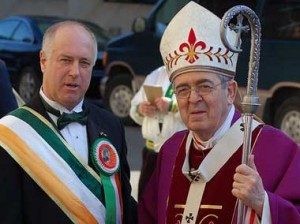By Marianne MacDonald
The Butcher Boy
Released: 1997
Genre: Dark Comedy
Synopsis: “The Butcher Boy” is Neil Jordan’s adaptation of the shocking, award-winning novel by author Patrick McCabe. That book shook the modern Irish literary world on its publication in 1992.
I had read the book before seeing the movie, so I had some trepidation. I wondered whether the movie would accurately portray the vividly portrayed characters of McCabe’s novel. Never fear … the movie successfully captured, in rich detail, young Francie Brady (Eamonn Owens), his Da (Stephen Rea at his usual brilliant best) and his Ma (Aisling Sullivan).
Set in the uneasy early ’60s at the time of the Cuban Missile Crisis, the story depicts an Ireland quite unlike the Ireland of thatched cottages, peat bogs and fiddlers by the fireside.
Young Francie was a typical pre-teen lad bent on playing cops & robbers with his pal Joe, and tormenting the life out of prissy Philip Nugent and his mother, played with chilling acumen by Fiona Shaw. As the plot unwinds, we learn of the deadly illnesses inflicting Francie’s parents. Ma is a certifiable loon, listening to the song of the day, “The Butcher Boy,” over and over again, as she swings from manic bouts of baking to despairing depths of depression. Da is a washed-up musician suffering from the alcoholism all too common among Irish men. The best parts of their lives already seem to have passed them by.
Eventually tragedy strikes the Brady family and Francie begins his own descent into a life of violence and madness as he tries to make sense of what is totally senseless. He loses all that he loved, and so he comes to see the world as his enemy—and rightfully so. From the righteous prigs of the town who look down on Francie and his Da, to the pedophiliac priests, to the horrors of the mental hospital to which he is eventually consigned, Francie inspires in the viewer a righteous anger at a world too ready to dismiss the child as “evil, wicked and no better than a pig.” When Francie returns to the town that turned away from him, we find his escalating sense of anger and overwhelming need for revenge strangely comprehensible.
Why it’s one of the best: Watching “The Butcher Boy” is a bit liking watching an accident as it happens, but it is still an unforgettable film. I saw it first in the movies and then rented it to watch at home. I caught it on cable a few years later. I found myself telling friends about it. The movie shows a side of Ireland (and indeed, it could be small-town America as well) that Bord Failte would sooner you never saw, or were even aware of. As difficult as it is to witness Francie’s loss of innocence, there are memorable moments. For example, Sinead O’Connor turns up in an hysterical portrayal of the Virgin Mary, and veteran actors Brendan Gleason and Milo O’Shea portray pedophiliac priests in the boys’ home where Francie is sent.
There is surely a lesson to be learned from this film. Is the message that all children are a product of their environment, that it takes a village to raise or damn a child or that childhood is either hell or heaven? That’s up to the viewer to decide. What is certain, though, is this: Once you’ve seen the film “The Butcher Boy” you will remember the horrors that can be visited upon the young, whether here in the U.S., in “idyllic” small-town Ireland or in any corner of the globe.
Disclaimer: This film is rated R for profanity/violence/adult situations and is not for the faint of heart.
Marianne MacDonald is host of “Come West Along the Road,” broadcast Sundays at noon on WTMR-AM (800 AM), with archived shows available on the Web.


